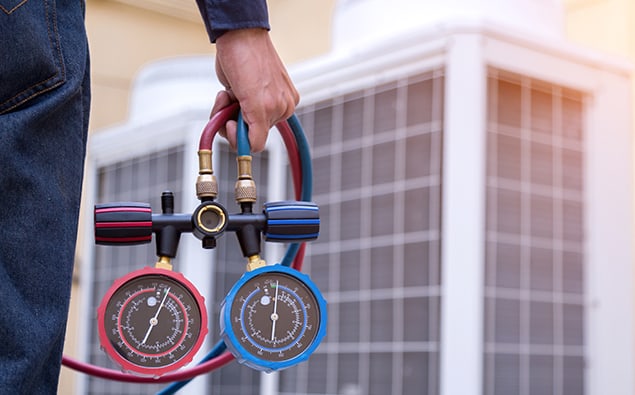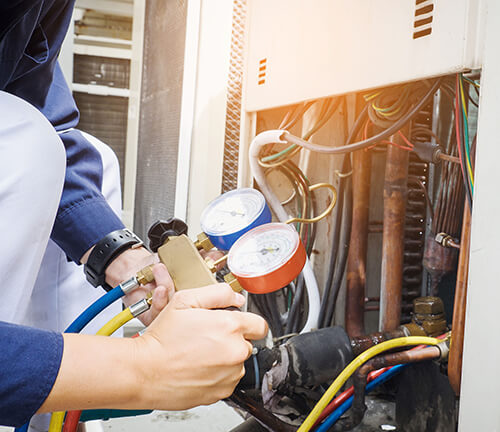The Significance of Cooling And Heating Installation: Secret Factors To Consider for a Comfy Indoor Atmosphere
The installment of a Cooling and heating system is an essential element in attaining an energy-efficient and comfortable interior atmosphere. Factors such as the viability of the system for details building needs, proper sizing to prevent ineffectiveness, and the proficiency of contractors for a top quality setup play pivotal functions. The adoption of advanced modern technologies can substantially enhance system efficiency.
Choosing the Right System

When picking a heating and cooling system, it is crucial to assess the capability needed to successfully warmth or cool down the room without straining the system, which can lead to increased wear and functional prices. Consulting with a professional a/c contractor can provide beneficial understandings right into picking a system that straightens with both the anticipated usage and the building style patterns of the structure.
Additionally, considering the integration of clever modern technology can boost system administration and surveillance, supplying better control and prospective expense financial savings. By meticulously assessing these factors, one can make certain the option of a HVAC system that not just satisfies immediate needs yet likewise contributes to lasting functional sustainability and passenger convenience.
Understanding Power Effectiveness
Recognizing energy effectiveness is necessary when considering a Cooling and heating installment, as it straight affects both the environmental footprint and the functional expenses of the system. The performance of a Heating and cooling system is typically suggested by rankings such as SEER (Seasonal Power Performance Ratio) for air conditioners or AFUE (Annual Gas Usage Effectiveness) for furnaces.

Spending in an energy-efficient HVAC system not just equates to cost financial savings however also adds favorably to environmental conservation by decreasing greenhouse gas discharges. Additionally, several jurisdictions use rewards or rebates for the setup of high-efficiency systems, even more boosting their economic allure.
When evaluating energy performance, consider advanced features such as variable speed electric motors, clever thermostats, and zoning capacities. These developments enhance the system's capacity to change to differing demand, therefore maximizing power usage. It is vital to consult with HVAC specialists who can provide understandings right into the most effective alternatives tailored to certain climate problems and use patterns, guaranteeing optimal efficiency and comfort.
Value of Appropriate Sizing

On the other hand, an undersized heating and cooling system will battle to reach the desired temperature level, particularly during severe weather. This can cause constant operation, leading to greater energy costs and possible overheating of system parts. Furthermore, inadequate sizing can bring about inconsistent temperature level distribution, causing specific areas of a building to be also cozy or as well cool.
To achieve the proper sizing, a detailed tons estimation is vital. This entails analyzing various aspects such as the building's square video footage, insulation degrees, home window types, and neighborhood climate conditions. By properly check my site identifying the home heating and cooling demands of a space, a/c professionals can suggest systems that make certain efficient operation, decreased energy usage, and improved indoor comfort.

Ensuring Quality Installation
A smooth Cooling and heating installation is the cornerstone of a system's long life and performance. This professional need to have extensive understanding of varied systems and be proficient at evaluating the particular needs of the building.
Proper installation exceeds simple placement of devices. It involves exact calibration to make certain optimal air flow, effective energy consumption, and consistent temperature circulation. This consists of accurate ductwork setup, guaranteeing connections are safe and secure and leak-free, which is crucial for maintaining system effectiveness and indoor air high quality.
Moreover, the implementation of sophisticated analysis tools throughout installment can detect prospective problems early, avoiding costly fixings and extending the lifespan of the system. The specialist must likewise make certain that all parts are suitable and that the system adheres to neighborhood building regulations and policies.
Normal Upkeep Practices
Once the foundation for a high-performing a/c system is established via quality installation, the emphasis must move to normal upkeep techniques to ensure ongoing performance and integrity. Routine maintenance not only extends the lifespan of the system yet additionally boosts interior air quality, decreases energy consumption, and protects against pricey fixings. Essential upkeep tasks include on a regular basis altering air filters, cleaning up evaporator and condenser coils, and examining the system for why not check here leaks or clogs.
This simple job can significantly enhance air circulation and system effectiveness. In addition, specialist specialists need to examine the system each year, inspecting for cooling agent degrees, electrical connections, and general system efficiency.
Attention to ductwork is likewise critical; sealing and cleansing air ducts consistently stops air loss and contamination. Implementing an upkeep timetable guarantees that minor issues are resolved before they rise, protecting the system's operational stability. By sticking to these upkeep techniques, property owners can enhance their HVAC system's functionality and preserve a comfy interior environment year-round.
Final Thought
By picking a proper system tailored to specific structure demands, understanding power efficiency, and ensuring appropriate sizing, inefficiencies can be decreased. The involvement of skilled service providers assurances quality setup, while the assimilation of sophisticated technologies improves system performance and tracking.
Numerous types of Cooling and heating systems are readily available, including split systems, crossbreed systems, duct-free systems, and packaged heating and air systems, each with distinctive advantages and restrictions.
Understanding power efficiency is vital when thinking about an A/c installation, as it straight affects both the ecological footprint and the operational costs of the system. The performance of an A/c system is generally suggested by rankings such as SEER (Seasonal Energy Performance Ratio) for why not look here air conditioners or AFUE (Annual Fuel Usage Effectiveness) for furnaces (air conditioning contractor in Brownwood TX).As soon as the foundation for a high-performing Heating and cooling system is developed with top quality setup, the emphasis needs to shift to normal upkeep practices to make sure continued performance and dependability. In addition, professional technicians should inspect the system yearly, examining for refrigerant degrees, electrical connections, and general system performance